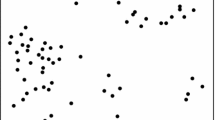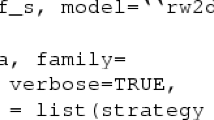Abstract
The Gibbsian T-tessellation models allow the representation of a wide range of spatial patterns. This paper proposes an integrated approach for statistical inference. Model parameters are estimated via Monte Carlo maximum likelihood. The simulations needed for likelihood computation are produced using an adapted Metropolis-Hastings-Green dynamics. In order to reduce the computational costs, a pseudolikelihood estimate is derived and then used for the initialization of the likelihood optimization. Model assessment is based on global envelope tests applied to the set of functional statistics of tessellation. Finally, a real data application is presented. This application analyzes three French agricultural landscapes. The Gibbs T-tessellation models simultaneously provide a morphological and statistical characterization of these data.


















Similar content being viewed by others
References
Adamczyk-Chauvat, K., Kiêu, K. (2015). LiTe. http://kien-kieu.github.io/lite
Arak, T., Clifford, P., Surgailis, D. (1993). Point-based polygonal models for random graphs. Advances in Applied Probability, 25, 348–372.
Baddeley, A., Rubak, E., Turner, R. (2016). Spatial Point Patterns: Methodology and Applications with R. Boca Raton: Chapman and Hall/CRC Press.
Dereudre, D. (2019). Introduction to the theory of Gibbs point processes. In D. Coupier (Ed.), Stochastic Geometry. Cham: Springer International Publishing.
Dereudre, D., Lavancier, F. (2011). Practical simulation and estimation for Gibbs Delaunay-Voronoi tessellations with geometric hardcore interaction. Computational Statistics and Data Analysis, 55, 498–519.
Devaux, C., Lavigne, C., Austerlitz, F., Klein, E. F. (2007). Modelling and estimating pollen movement in oilseed rape (Brassica napus) at the landscape scale using genetic markers. Molecular Ecology, 16, 487–499.
Fletcher, R. (1987). Practical Methods of Optimization (2nd ed.). Chichester: Wiley.
Gaucherel, C. (2008). Neutral models for polygonal landscapes with linear networks. Ecological Modelling, 219, 39–49.
Geyer, C. J. (1994). On the convergence of Monte Carlo Maximum Likelihood calculations. Journal of the Royal Statistical Society, Series B, 56, 261–274.
Geyer, C. J., Thompson, E. A. (1992). Constrained Monte Carlo Maximum Likelihood for dependent data. Journal of the Royal Statistical Society, Series B, 54, 657–699.
Gilbert, E. N. (1967). Random plane network and needle-shaped crystals. In B. Noble (Ed.), Applications of Undergraduate Mathematics in Engineering. New York: Macmillan.
Kahn, J. (2015). How many T-tessellations on k lines? Existence of associated Gibbs measures on bounded convex domains. Random Structures & Algorithms, 47, 561–587.
Kiêu, K., Adamczyk-Chauvat, K. (2015) Pseudolikelihood inference for Gibbsian T-tessellations. . . and point processes. https://hal.archives-ouvertes.fr/hal-02793013/
Kiêu, K., Adamczyk-Chauvat, K., Monod, H., Stoica, R. (2013). A completely random T-tessellation model and Gibbsian extensions. Spatial Statistics, 6, 118–138.
Le Ber, F., Lavigne, C., Adamczyk, K., Angevin, F., Colbach, N., Mari, J. F., Monod, H. (2009). Neutral modelling of agricultural landscapes by tessellation methods-application for gene flow simulation. Ecological Modelling, 220, 3536–3545.
Leon, R., Nagel, W., Ohser, J., Arscott, S. (2020). Modeling crack pattern by modified STIT tessellations. Image Analysis and Stereology, 39, 33–46.
Mackisack, M., Miles, R. (1996). Homogeneous rectangular tessellations. Advances in Applied Probability, 28, 993–1013.
Myllymäki, M., Mrkvička, T. (2020). GET: Global envelopes in R. arXiv:1911.06583 [statME] arXiv: org/abs/1911.06583
Myllymäki, M., Mrkvička, T., Grabarnik, P., Seijo, H., Hahn, U. (2017). Global envelope tests for spatial processes. Journal of the Royal Statistical Society: Series B (Statistical Methodology), 79, 381–404. https://doi.org/10.1111/rssb.12172
Nagel, W., Weiss, V. (2005). Crack STIT tessellations: Characterization of stationary random tessellations stable with respect to iteration. Advances in Applied Probability, 37, 859–883.
Nagel, W., Mecke, J., Ohser, J., Weiss, V. (2008). A tessellation model for crack patterns on surfaces. Image Analysis and Stereology, 27, 73–78.
Okabe, A., Boots, B., Sugihara, K., Chiu, S. N. (2009). Spatial Tessellations: Concepts and Applications of Voronoi Diagrams. New York: Wiley.
Penttinen, A. (1984). In: Modelling Interaction in Spatial Point Patterns: Parameter Estimation by the Maximum Likelihood Method, vol 7, Jyväskylä Studies in Computer Science, Economics, and Statistics. University of Jyväskylä
Poggi, S., Papaïx, J., Lavigne, C., Angevin, F., Le Ber, F., Parisey, N., Ricci, B., Vinatier, F., Wohlfahrt, J. (2018). Issues and challenges in landscape models for agriculture: from the representation of agroecosystems to the design of management strategies. Landscape Ecology, 33, 1679–1690.
Poggi, S., Delaplace, A., Pichelin, P., Le Cointe, R. (2020). History of land uses over the period 2013-2019 in the Kervidy-Naizin watershed (Brittany, France). https://doi.org/10.15454/ATYOBO
Poggi, S., Vinatier, F., Hannachi, M., Sanz Sanz, E., Rudi, G., Zamberletti, P., Tixier, P., Papaïx, J. (2021). How can models foster the transition towards future agricultural landscapes? Advanced in Ecological Research, 64, 305–368.
Ricci, B., Franck, P., Toubon, J. F., Bouvier, J. C., Sauphanor, B., Lavigne, C. (2009). The influence of landscape on insect pest dynamics: a case study in southeastern France. Landscape Ecology, 24, 337–349.
Schreiber, T., van Lieshout, M. N. M. (2010). Disagreement loop and path creation/annilihation algorithms for binary planar Markov fields with applications to image segmentation. Scandinavian Journal of Statistics, 37, 264–285.
Seitl, F., Petrich, L., Staněk, J., Krill, C., III., Schmidt, V., Beneš, V. (2021). Exploration of Gibbs-Laguerre tessellations for three dimensional stochastic modeling. Methodology and Computing in Applied Probability, 23, 669–693.
Stoica, R. S., Philippe, A., Gregori, P., Mateu, J. (2017). An ABC method for posterior sampling of marked point processes. Statistics and Computing, 27, 1225–1238.
Stoyan, D., Kendall, W. S., Mecke, J. (1995). Stochastic geometry and its applications (2nd ed.). Chichester: Wiley.
van Lieshout, M. N. M. (2012). An introduction to planar random tessellation models. Spatial Statistics, 1, 40–49.
Vihrs, N., Møller, J., Gelfand, A. E. (2021). Approximate Bayesian inference for a spatial point process model exhibiting regularity and random aggregation. Scandinavian Journal of Statistics, 48, 969–1000.
Acknowledgements
This work was supported partly by the French PIA project “Lorraine Université d’Excellence” (ANR-15-IDEX-04-LUE) and by the SMACH Metaprogram (Sustainable Management of Crop Health) of the French National Research Institute for Agriculture, Food and Environment. The BVD and the Kervidy landscape data were kindly provided by Claire Lavigne (INRAE, Centre de PACA) and Sylvain Poggi (INRAE, Centre de Bretagne-Normandie). We are grateful to the authors of the online library “Texturelib” for the examples of tessellation patterns shown in Fig. 1. We would like to thank Ms. Gail Wagman for her contribution to improving the English of the manuscript. We are grateful to the Reviewers for helpful and constructive comments.
Author information
Authors and Affiliations
Corresponding author
Additional information
Publisher's Note
Springer Nature remains neutral with regard to jurisdictional claims in published maps and institutional affiliations.
Kiên Kiêu died on 27.02.2017 after an earlier version of this paper had been prepared. The remaining authors take full responsibility for the present version.
Appendices
A. Algorithm for approximating a landscape pattern by a T-tessellation
The algorithm first approximates a landscape pattern by a line-based tessellation containing the L-vertices, the I-vertices and the X-vertices (see Figs. 8 and 17). In the second step, these vertices are converted into T-vertices.
The algorithm requires the numerical representation of the landscape composed from the list of the plots coordinates, the list of the holes coordinates (the holes correspond to non-arable areas) and the coordinates of the outer domain.
Grouping polygon sides
The algorithm starts by grouping the sides of polygons that are close and nearly aligned. This is done by hierarchical clustering based on the single linkage method. A measure of dissimilarity between the sides can be adjusted to account for specific landscape features. Hereafter, the following dissimilarity matrix was applied:
where \(A(C(c_i,c_j))\) denotes the area of the convex envelope of the sides \(c_i\) and \(c_j\), \(d_{\min }(c_i,c_j)\) is the smallest Euclidean distance between \(c_i\) and \(c_j\), and l(.) denotes the length of the side.
Choice of representative segments
The clusters of sides are then replaced by representative segments. For a given cluster, a regression line is fitted to the endpoints of its sides. A representative segment is defined as the minimal segment containing the projections of all endpoints on the regression line (see Fig. 18). The segments representing the side clusters are inserted into a landscape domain. The resulting segment-based tessellation contains three types of vertices: I-vertices with one incident edge, L-vertices with two incident edges, and X-vertices formed by the crossing segments (see Fig. 17).
Transformation into T-tessellation
In order to transform an I vertex into a T-vertex, the incident edge is either removed or lengthened until it meets another edge. The modification that induces the smallest variation in total internal length of tessellation is selected. An L-vertex is transformed into a T-vertex by lengthening one of the incident edges. The choice of the edge is also based on the comparison of length variation.
The algorithm starts by iteratively removing the I-vertices: the vertex whose suppression induces the smallest variation in length is selected at each iteration. The L-vertices are then removed following the same rule. The resulting tessellation contains the T-vertices and the X-vertices. An X-vertex can be suppressed by moving the endpoint of one of its four incident edges along a neighboring edge. The procedure is repeated until there is no X-vertex left in the tessellation. Figure 17 illustrates the modifications of I-, L- and X-vertices.
B. Numerical examples of T-tessellation construction
1.1 B.1 Sampling from the CRTT model
This section gives an example of source code for sampling from the CRTT model with scale parameter \(\theta\) (see Example 1) with Algorithm 1 implemented in the RLiTe package (see Adamczyk-Chauvat and Kiêu (2015)):

1.2 B.2 Random splits
In this section, the algorithm for simulating the T-tessellation of a bounded window W by a sequence of random splits is provided. It can be applied to create a tessellation of an empty window or to modify the non-empty tessellation, e.g., to add dummy splits to the existing tessellation in the pseudolikelihood optimization algorithm.
The following notation is used:
-
\(e=(p_1,p_2)\): an oriented edge of a tessellation T (halfedge for short) with the starting point \(p_1\) and the ending point \(p_2\);
-
c(e): tessellation cell bounded by e and located on the left side of e
-
\({{{\mathcal {E}}}}(T)\): ordered list of halfedges of T
Two auxiliary algorithms, 3 and 4, are first introduced and applied in the main algorithm 5.
About this article
Cite this article
Adamczyk-Chauvat, K., Kassa, M., Papaïx, J. et al. Statistical inference for random T-tessellations models. Application to agricultural landscape modeling. Ann Inst Stat Math 76, 447–479 (2024). https://doi.org/10.1007/s10463-023-00893-3
Received:
Revised:
Accepted:
Published:
Issue Date:
DOI: https://doi.org/10.1007/s10463-023-00893-3









